
How to build a strong employer brand in Tech

As Jeff Bezos, Founder and CEO of Amazon says, “Your brand is what other people say about you when you’re not in the room.“
How do you make sure what is being said reflects what it’s like to work at your organization? According to LinkedIn data, 80% of talent acquisition managers believe that employer branding has a significant impact on the ability to hire great talent. Given the gravity of this statistic, employer branding should be your priority in years to come. Here’s why.
Benefits of a strong employer brand
-
Recruiting advantage,
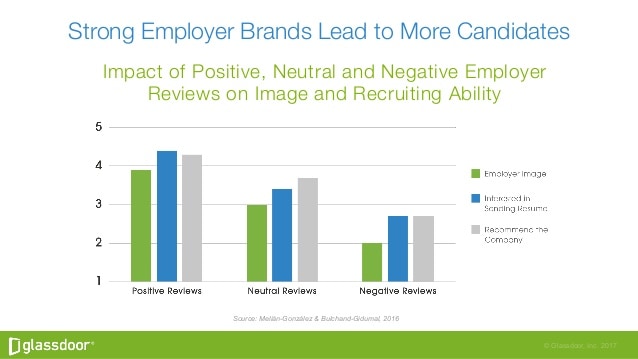 Source: Slideshare
Source: Slideshare
Findings of an academic study by Melián-González & Bulchand-Gidumal(via PR Newswire) indicate job seekers “are more interested to send their resume to a company after seeing a positive review versus a neutral or negative review.” Additionally, research from LinkedIn shows you get twice as many candidates in your talent pipeline when you build and maintain a strong employer brand.
Salary implications,

Source: Slideshare
According to a Harvard Business Review and ICM Unlimited study, negative reputation costs companies at least 10% more per hire. Furthermore, research from Melián-González & Bulchand-Gidumal (via PR Newswire) shows participants who saw positive reviews of an organization required a lower pay increase (35%-40%) than those shown neutral and negative reviews (45%-50% and 55%-60% pay increase respectively).
-
Dealing with a lack of trust and fear of change,
Based on LinkedIn data, not knowing what it’s like to work for a company is the #1 roadblock to changing jobs. A strong employer brand gives people the confidence they need so much and helps them make the move into the unknown.
-
Cost-per-Hire & turnover reduction.
According to statistics, a strong employer brand cutsCost-per-Hire by 43%.
How to build a strong employer brand in tech
1. Design an employer branding strategy for tech candidates
Have you got an employer branding strategy? According to CareerArc, only 57% of employers do. Do you know industry benchmarks and what they are in comparison to your own results? You definitely should. The ideal scenario is to have a written document you can go back to in order to ensure your efforts are always in agreement with your desired outcome. You also need a plan you can bring into action step by step to make sure progress doesn’t stall at any point.
How to get started? I’d advise you to sit down with your talent acquisition team and think about the following factors:
- What do developers find appealing in your company? Do you use this information in your employment process?
- Do you know the biggest problems of hiring in tech? How can you address them in your content? Do you currently talk about these subjects in your content?
- Do you know your biggest hiring obstacles and make a conscious effort to steer away from them?
- Does your communication stand out? What can you do to steer from generic job ads? Do you think you’d benefit from being more creative in your tech recruitment efforts?
- Where do you focus your employer branding efforts? Is it your website, your Career site, your company page on LinkedIn, or somewhere else?
- Are you present and/or active on developer-specific sites like Stack Overflow and GitHub? If so, are your efforts there planned? How do you evaluate your outcomes?
- Who is responsible for employer branding in your organization? How many people manage your employer brand? Do these people speak in unison or make your image inconsistent?
- How do you measure your employer branding? If you don’t, it’s the best moment to start doing it. CareerArc data shows “only 33% of employers track employer branding initiatives to at least one HR performance metric (eg. CPH, retention rate, cost per application, etc.)”. You’ve still got a head start as this area is clearly unappreciated.
Here’s a handy infographic from TalentLyft about creating an employer branding strategy in 5 steps:
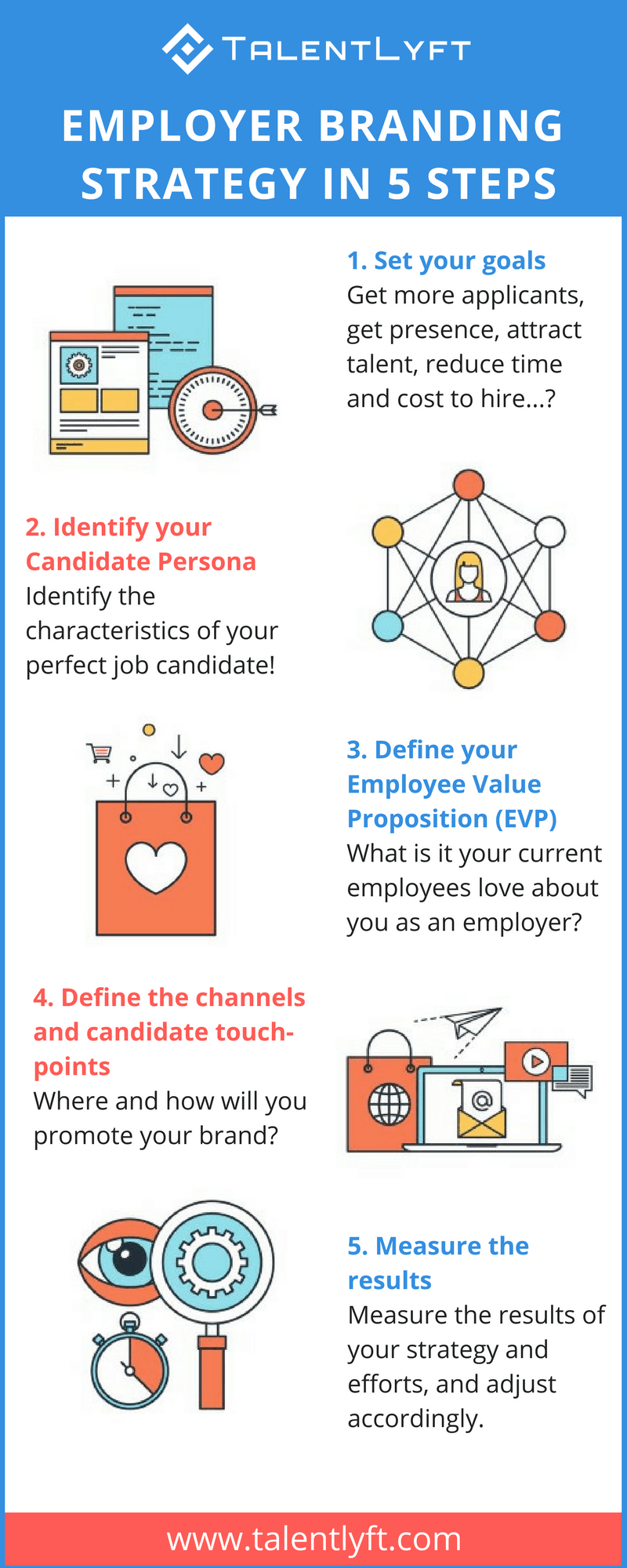
2. Target tech workers with dedicated ads
There are many examples of creative HR in tech, but the secret is making a reference to what makes developers who they are. One way of doing it is to use ads written by people who understand the specifics of the job, or even better, create a challenge for the potential employee. This makes content more relatable and establishes a relationship early on.
One such example is this ad from Microsoft:
 Source: istartedsomething
Source: istartedsomething
The reason why it is so appealing is that it can only be understood by a certain group of people with a very specific way of thinking. There’s a sense of belonging, exclusiveness if you like, of the coding club. These types of ads attract people who enjoy challenges, puzzles, mathematical problems and are generally into problem-solving.
Here’s another example:
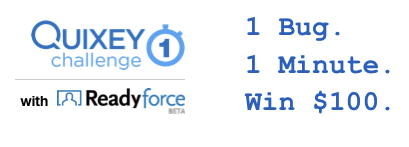 Source: Beamery blog
Source: Beamery blog
Ads of this kind strengthen your employer brand because they establish a clear association of being a tech-savvy organization which can provide growth opportunities for developers particularly. A word of caution at this point is to make sure that whatever comes after your creative advertising is top-notch because it sets expectations high. One way to do it is to imitate Google’s innovative “foo.bar” campaign. It was essentially a series of challenges which people could find after googling some code-related queries. Google sent them a clear message: “You’re speaking our language. Fancy a challenge?” and asked them to complete a series of puzzles. What I like about the campaign is that successful candidates were reinserted “in the usual Google recruitment programme, albeit with a big head start.” Don’t try to fix something that isn’t broken. Instead, try to find new ways to get your pipeline full.
Need more examples of creative recruitment in tech? Check out this great post presenting “8 absolutely crazy recruitment campaigns”.
3.Turn your weaknesses into strengths
Let us now have a look at GE’s “Owen campaign”. Here’s a couple of the ads from the series:
Part of the reason why the campaign was so successful is that it acknowledged how some people think of the company and worked to change it. Owen is excited about his new job but others are rather cool and don’t understand that a company like GE gives developers a chance to grow. They seem more excited about some weird cat app which has little to do with engineering based on a very simple association that apps = developer jobs.
GE was able to strengthen its employer brand because it challenged people’s associations and worked to change them.
4. Build new associations with storytelling
Not only does GE challenge their stereotypical image, they also work hard to build a new one. One of the ways to achieve this is via storytelling ads like these:
“What my Mom does at GE”:
https://www.youtube.com/watch?v=Co0qkWRqTdM
(MUST. NOT. CRY.)
“Meet Molly, the Kid Who Never Stops Inventing”:
https://www.youtube.com/watch?v=sucKTktHYA8
These ads work so beautifully because they humanize the company and make viewers emotionally involved. First of all, they create an image of a female-friendly and parent-friendly workplace, but they also show what sort of projects employees deal with in a subtle way. What I find particularly attractive is that these don’t show offices, pool tables or computers but tell you a story of GE’s employees. As an example, the Molly advert shows how working at GE naturally fits the employee and not the other way around.
5. Strengthen your position at universities
According to LinkedIn research, 66% of people who changed jobs recently were aware of the existence of the company before hearing about the job opportunity. There are a number of ways to increase brand awareness early on, and universities are one of the best places to start. That said, traditional student fairs are only one way of doing it, and not the most innovative one to be frank.
Need fresh ideas?
Check. This. Out.
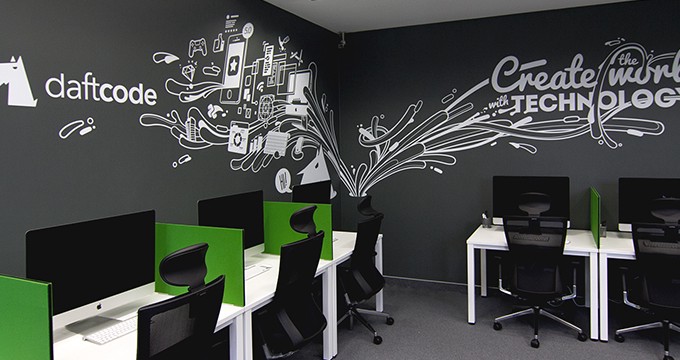
Source: DaftCode
Isn’t that gorgeous? No, that’s not Daftcode’s office space. It’s the result of DaftCode’s cooperation with The University of Warsaw.
DaftCode is a Warsaw-based company that decided to “reach out to the young generation of programmers, which are soon to enter the labor market” by means of this computer lab at the Faculty of Mathematics, Informatics, and Mechanics. The space resembles DaftCode’s original office and is designed with the needs of developers in mind. According to DaftCode, their “brand awareness among students is estimated at more than 90%”. DaftCode’s initiative is a brilliant example of non-standard activities directed at their potential employees.
The company also placed its logo on a billboard at the Politechnika metro station in Warsaw.

Source: DaftCode
These were later substituted with more original ads with a coding puzzle:
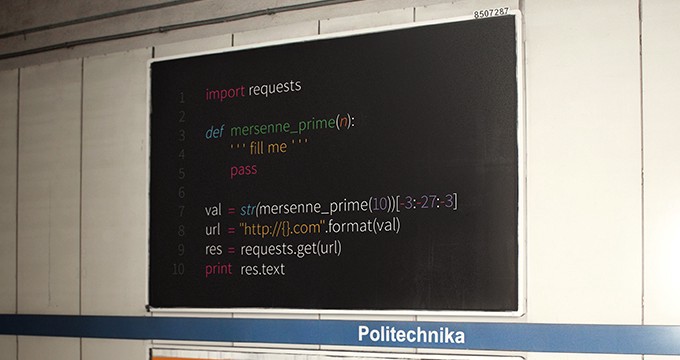
Source: DaftCode
The solution made a reference to the original billboard, with congratulations and an invitation to contact.

Source: DaftCode
As a result of the campaign, a total of 50 people sent their answers and 35 people came into DaftCode’s office. As the final outcome of the campaign, 5 people were invited to cooperate.
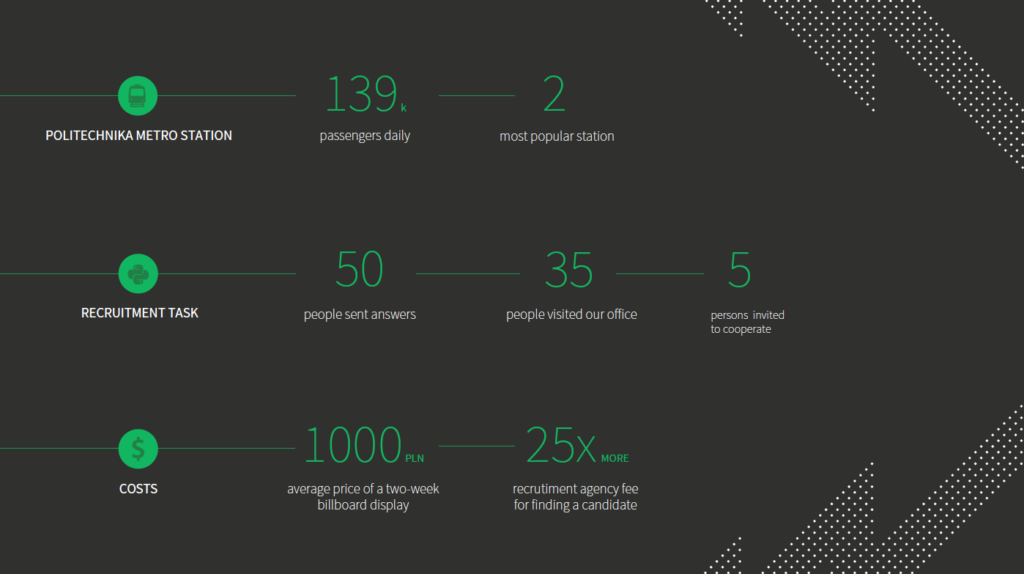 Source: DaftCode
Source: DaftCode
Not only was it very creative, but it was also cheap to execute. DaftCode data states it was 25x cheaper than recruitment agency fee for finding a candidate. Well played, DaftCode. Well played.
6. Attract more female candidates
 GoDaddy faced a major employer branding problem – in 2014, “only 14% of GoDaddy’s engineering interns and new graduates hires were women in 2014”. That’s because their early advertising strategy didn’t correspond with what they could actually offer as an employer. Have a look yourself:
GoDaddy faced a major employer branding problem – in 2014, “only 14% of GoDaddy’s engineering interns and new graduates hires were women in 2014”. That’s because their early advertising strategy didn’t correspond with what they could actually offer as an employer. Have a look yourself:
Their ads did the job and increased brand awareness significantly, but they didn’t do GoDaddy a favor when it comes to recruiting women. The frat boy culture wasn’t that appealing, plus you couldn’t really grasp what they did at the company. Most people didn’t even realize GoDaddy was a tech company in the first place.
That said, when the company made a conscious effort to change their marketing & recruitment strategies, that number increased to 39% in 2015. According to GoDaddy Vice President of Talent Acquisition Andrew Carges, they implemented a four-tier process to hire more women. Here’s what they did:
- Took care of visibility at women-in tech-events. They sponsored conferences (not without a fair amount of drama as people were initially suspicious) and as time passed, it became evident that the company was serious about making a change,
- Hosted bi-quarterly events for their employees. These were organized around female entrepreneurs and women’s rights. The idea was to “reinforce GoDaddy’s commitment to women, while also providing an inspirational and entertaining session for their employees”,
- Made the company bias-free with tools and training. The goal was to remove all bias (including unconscious bias) from managers and recruiters,
- Increased visibility in high schools and colleges where GoDaddy encouraged female students to educate themselves and become technical professionals. Their motivation was to “grow the pie, so there’s more candidates for everyone”.
GoDaddy’s efforts clearly paid off and once their marketing and recruitment strategies were aligned, they ended up with diverse teams they wanted so much.
7. Take care of your reviews
According to Jobvite, online research is the second biggest factor influencing a candidate’s impression of a job. When people start looking into a given job opportunity, they typically analyze company reviews on third-party sites. According to Glassdoor, 61% of users of the site say they look for “company reviews and ratings before making a decision to apply for a job.” There are a number of things you can do to make sure your employer brand is strong. You can monitor your brand name, names of your C-level executives, but most importantly keep an eye on your company profile on sites like Glassdoor. Based on Edelman Trust Barometer research, “Employee voice is 3x more credible than the CEO when it comes to talking about working condition in that company.” Make sure what your C-suite have to say doesn’t clash with the reviews of less senior employees, especially former ones.
If you do part ways with someone, try to be fair and provide support throughout the process. Leaving a company or being let go is a difficult time which makes people more emotional and vulnerable. It’s much easier to upset or offend them which may result in serious reputation damage.
Another factor to consider at this point is your onboarding process – it has to be impeccable so you don’t get recurring negative reviews from people who only stayed around for a little while. Interestingly though, strong employer brand can actually help you prevent people from leaving. Based on research from CareerArc, “new hires of companies with a strong employer brand are 40% less likely to leave after the first 6 months.”
If you do get a review (especially a negative one), make sure to reply. According to Glassdoor data, “62% of users agree their perception of a company improves after seeing an employer respond to a review.”
8. Encourage your devs to learn
According to Deloitte, “Organizations with a strong learning culture are 92% more likely to develop novel products and processes, 52% more productive, 56% more likely to be the first to market with their products and services, and 17% more profitable than their peers.” This corresponds with the mindset of the people you’re trying to hire as a tech recruiter. The opportunity to grow professionally is appealing to developers as 70% of them believe learning new technologies is important at work (Stack Overflow). Let your programmers learn, sponsor courses and encourage self-learning.
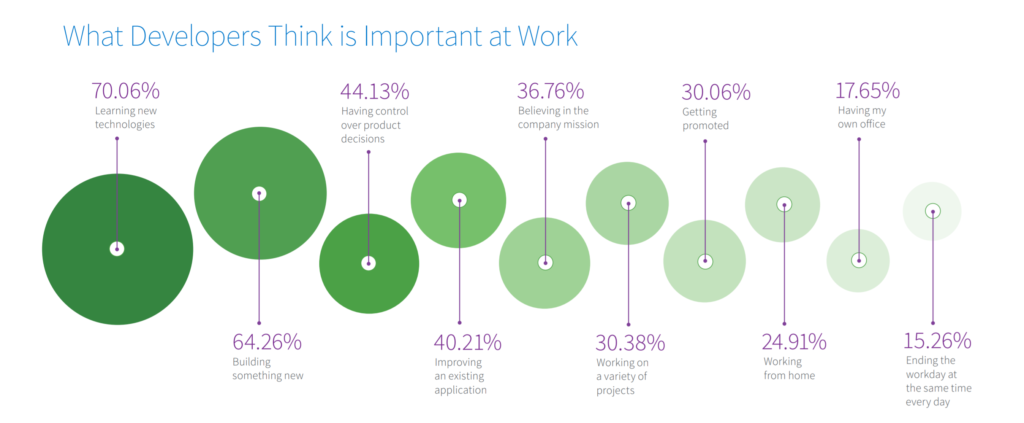
Source: Stack Overflow
9. Create brand ambassadors
Encourage your team members to share their knowledge and expertise of the industry in blog posts and resources. Use your brand to help your technical professionals get recognition and leverage your social media channels to promote them. Include their quotes and profiles in your communication, on your Career page or in official profiles, i.e. on Stack Overflow. This humanizes your brand and makes it more relatable to potential hires.
Conclusion
Growing your employer brand in tech is an ongoing process. Although it’s not an easy road, the benefits are manifold, so all the hard work pays off.
What are your favorite techniques to strengthen your employer brand?




